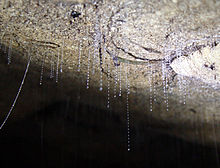Malpighian tubule system
The Malpighian tubule system is a type of
The system consists of branching
Structure

Malpighian tubules are slender tubes normally found in the posterior regions of arthropod alimentary canals. Each tubule consists of a single layer of cells that is closed off at the distal end with the proximal end joining the alimentary canal at the junction between the midgut and hindgut. Most tubules are normally highly convoluted. The number of tubules varies between species although most occur in multiples of two. Tubules are usually bathed in
completely lack a Malpighian tubule system.General mode of action
Pre-urine is formed in the tubules, when
Alternative modes of action
Complex cycling systems of Malpighian tubules have been described in other insect orders.
Other uses

Although primarily involved in excretion and osmoregulation, Malpighian tubules have been modified in some insects to serve accessory functions. Larvae of all species in genus Arachnocampa use modified and swollen Malpighian tubules to produce a blue-green light[1] attracting prey towards mucus-coated trap lines. In insects which feed on plant material containing noxious allelochemicals, Malpighian tubules also serve to rapidly excrete such compounds from the hemolymph.
See also
References
- ^ Green, L.B.S. (1979) The fine structure of the light organ of the New Zealand glow-worm Arachnocampa luminosa (Diptera: Mycetophilidae). Tissue and Cell 11: 457–465.
- Gullan, P.J. and Cranston, P.S. (2000) The Insects: An Outline of Entomology. Blackwell Publishing UK ISBN 1-4051-1113-5
- Romoser, W.S. and Stoffolano Jr., J.G. (1998) The Science of Entomology. McGraw-Hill Singapore ISBN 0-697-22848-7
- Bradley, T.J. The excretory system: structure and physiology. In: Kerkut, G.A. and Gilbert, L.I. eds. Comprehensive insect physiology, biochemistry and pharmacology. Vol.4 Pergamon Press New York ISBN 0-08-030807-4pp. 421–465
